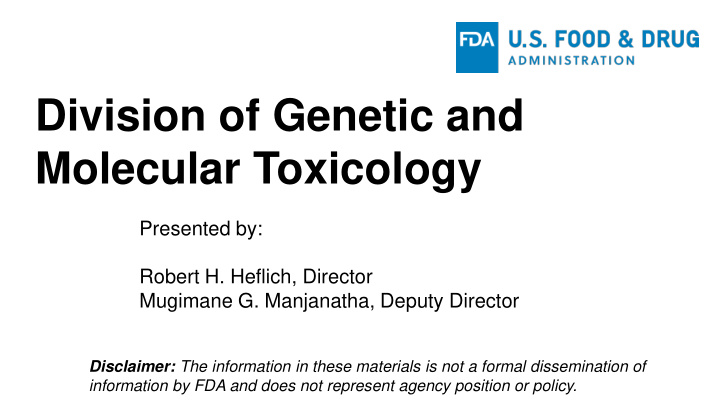



Division of Genetic and Molecular Toxicology Presented by: Robert H. Heflich, Director Mugimane G. Manjanatha, Deputy Director Disclaimer: The information in these materials is not a formal dissemination of information by FDA and does not represent agency position or policy.
DGMT Staff • Government Positions (# Full time exployees) - Research Scientists, Staff Fellows & Visiting Scientists: 15 - Support Scientists: 10 - Administrative: 2 - FDA Commissioner Fellows: 0 • ORISE Post Docs, Graduate Students, etc.: 7 • Total = 34 staff members (increased by 5 from 2017) www.fda.gov 2
DGMT Outreach (details in Subcommittee Review Materials) Collaborations • o NCTR Divisions: DBT (Chemistry support), DSB (tissue models), DBB (NGS data analysis), Pathology o FDA regulatory centers: CDER, CTP, CBER o Government agencies: NIEHS/NTP, EPA • Global leadership outreach -- leadership in: o HESI o IWGT and OECD committees o SOT o EM GS www.fda.gov 3
DGMT Mission and Goals • Mission Improve public health by providing FDA with the expertise, tools, and approaches necessary for comprehensive assessment of genetic risk. • Goals – Respond to Agency needs for chemical-specific data (e.g., nanomaterials, tobacco products, drug impurities). – Maintain DGMT’s tradition of leadership in regulatory assay development and validation (e.g., MLA, Hprt , TGR, Pig-a ). – Establish new paradigms for regulatory decision making that integrate measures of genetic risk with biomarkers of toxicity. www.fda.gov 4
DGMT Strategies • Engage FDA product centers, NTP, and other national and international organizations to set research priorities. • Develop better biological models for assessing human risk. • Develop more comprehensive approaches for monitoring genetic variation. • Develop better ways of evaluating data to determine human risk. www.fda.gov 5
Top Accomplishments During the Last 5 Years Progress made on defining the mutational basis for the in vivo erythrocyte Pig-a assay – evaluating mutation induction in bone marrow erythroids and granulocytes. www.fda.gov 6
Top Accomplishments During the Last 5 Years Showed that interindividual variation in cancer driver mutant fraction can be used to identify mutations with the greatest carcinogenic impact in specific human tissues. www.fda.gov 7
Top Accomplishments During the Last 5 Years Using metabolically competent human cells and HTHC methodology to screen for genetic toxicity, e.g., EpiComet, HepaRG/primary human hepatocytes coupled with CometChip and MultiFlow technology. www.fda.gov 8
Top Accomplishments During the Last 5 Years Implementing methods for treating tissue models with vapors, aerosols, and cigarette smoke for conducting in vitro studies of inhaled toxicants. www.fda.gov 9
Top Accomplishments During the Last 5 Years Developing a panel of disease-relevant molecular and physiological endpoints for evaluating toxicity in organotypic tissue models. www.fda.gov 10
Top Accomplishments During the Last 5 Years Taking advantage of the power of error-corrected next-generation sequencing to tackle previously intractable problems in genetic toxicology, e.g., whole genome (unbiased) mutation detection, nanomaterial mutation (follow-up discussed at Subcommittee Review). www.fda.gov 11
Examples of projects that are newly initiated or in development, along with future plans Attend the DGMT Subcommittee Review immediately following the full SAB meeting for more details! www.fda.gov 12
Future Directions • Establish/adapt more genetic toxicology endpoints to complement the array of general toxicology endpoints developed for in vitro tissue models: e.g., Comet, micronucleus, and gene mutation for the ALI airway model (proposal at Subcommittee Review). • Develop complementary rodent and human in vitro tissue models as a bridge between rodent data and human responses. www.fda.gov 13
Future Directions Develop in vitro approaches for evaluating reproductive toxicity , including germ cell mutation (presentation at Subcommittee Review). www.fda.gov 14
Future Directions Use computational modeling approaches (e.g., CFD modeling) to use in vitro data to evaluate human responses. www.fda.gov 15
Feedback Requested • Are we doing an adequate job in terms of outreach and serving FDA needs in the field of genetic toxicology? • Is our emphasis on research involving advanced genetic analysis techniques and in vitro organotypic models appropriate? • Should we place more emphasis on microphysiological systems? www.fda.gov 16
Feedback Requested • Are we placing an appropriate level of emphasis on germ cell effects (recommendation by our last Subcommittee Review)? • Should we place more emphasis on in vitro to in vivo extrapolation? • Should we limit this to in vitro inhalation models? • Should we consider modeling Cancer Driver Mutation kinetics in relation to tumor response? www.fda.gov 17
Recommend
More recommend